Recycling
DOI:
https://doi.org/10.11137/2005_2_139-151Abstract
Dimension stone industry produces a great amount of effluents, about 200,000 ton/year per solid residue. Espírito Santo State has about 600 companies, and their average consume per industry is around are 10,000 l/ day of water. Those rejects are displaced in decant lagoons, and landfill. In this work was used material provided by marble & granite industry from Cachoeiro de Itapemirim, ES. Those residues were characterized by chemical and mineral composition, physical properties, sintering process, and point load test. The results provided from physical indices and sintering material were compared with the results of commercial granite named in Industry as "granito rosa bavena". Analysis allowed us to get a conclusion about the reject. These analyses showed that reject could be used as a source for ceramic material, with the possibility of choosing for a greater or lower resistance.Downloads
Download data is not yet available.
Downloads
Published
2005-01-01
How to Cite
Mothé Filho, H. F., Polivanov, H. and Mothé, C. G. (2005) “Recycling”, Anuário do Instituto de Geociências. Rio de Janeiro, BR, 28(2), pp. 139–151. doi: 10.11137/2005_2_139-151.
Issue
Section
Article
License
This journal is licensed under a Creative Commons — Attribution 4.0 International — CC BY 4.0, which permits use, distribution and reproduction in any medium, provided the original work is properly cited.















